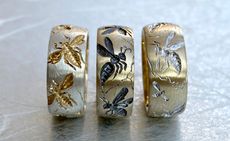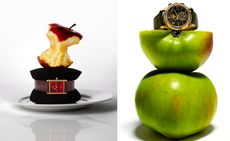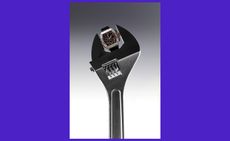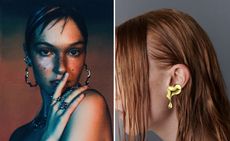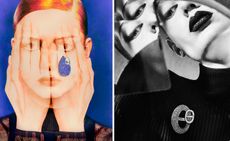Hip-hop, jewellery and identity: a visual history
A new book from Taschen, Ice Cold. A Hip-Hop Jewelry History, explores the enduring relationship between two creative fields
- (opens in new tab)
- (opens in new tab)
- (opens in new tab)
- Sign up to our newsletter Newsletter
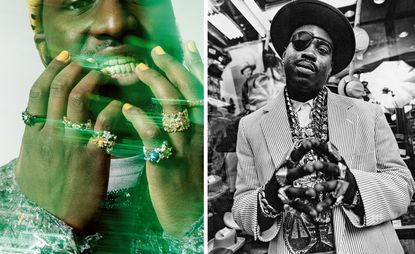
‘With hip-hop, the history of the jewellery is woven into the fabric of the music,’ says author Vikki Tobak, who has explored the relationship between the two creative fields in her new book published by Taschen, Ice Cold. A Hip-Hop Jewelry History. Travelling back four decades and including essays by Slick Rick, A$AP Ferg and LL COOL J, amongst others, the tome touches on everything from street style to the biggest names in hip-hop and iconic jewellers. Here, she tells us what drew her to the subject, what surprised her in her research and her delight at the power of a good watch collection.

Eric B and Rakim. Rakim wears a Mary pendant on layered gold rope chains, while Eric B. wears an anchor pendant and eagle motif pendant on gold rope chain, gold nugget watch, and multiple gold nugget rings, including pinky ring with a Mercedes-Benz motif and a four-finger nameplate ring spelling out his full name— Louis Eric Barrier— in classic script. David Corio, 1987.
Wallpaper*: Jewellery's role in hip hop has helped define a strong visual identity over the decades. Where do you begin when exploring this relationship?
Vikki Tobak: Hip-hop jewellery is so much bigger than conspicuous consumption and I really wanted this book to celebrate something bigger than just bling. Style is a visual dialogue. Hip-hop took that dialogue and, with a clarity of vision and Black diasporic history, elevated all the way to global dominance - unapologetic, charismatic, and dripping in street savvy. Artists use jewellery to express their individuality, their identity, allegiance to neighbourhoods, crews, brotherhoods, label affiliations and so on.
With hip-hop jewellery, it’s almost impossible to separate the gemstones from the bigger narrative of politics, identity and race, and historical complexity. That’s where I wanted to start as the foundation for this story. Setting the tone of street culture, African aesthetics and the historical connotations were really important.
From there, we celebrate the artists who so beautifully express themselves through jewellery and the jewellery subculture that emerged as hip-hop was rising to power. And with hip-hop’s intersection with luxury goods now a given, there’s an even deeper story to be told of how the culture stepped into its power.

Jacob “The Jeweler” Arabo of Jacob & Co. Jacob “The Jeweler,” seen here in his Diamond District shop, became the premier jeweler as hip-hop stepped into its power in the 1990s. Name checked in scores of hip-hop lyrics, he helped usher in the era of platinum and diamonds for the culture. Jamel Shabazz, New York, 1990s.
W*: Are there any defining jewellery moments which stand out as turning points to you?
VT: Hip-hop’s love of jewellery builds on a history of visual cues as status. There are so many milestone moments in the jewellery game: you start with the street culture that the rappers were looking to in the beginning, then as hip-hop artists started to ascend you had artists like Big Daddy Kane, Rakim, Biz, Roxanne Shante wearing all the big gold truck style jewellery. Then in the early 90s Biggie had jeweller Tito create his Jesus piece setting off a trend, then Jay-Z and Diddy got hip-hop into platinum and diamonds alongside the rise of grills culture with early pioneers like Eddie Plein.
When folks like Pharrell started using coloured gems and collaborating with Jacob the Jeweller we saw a door open to more experimentation with materials such as enamel, and nods to anime and cartoon culture. Then you start to see Gucci Mane come in and elevate the jewellery game and the rise of the South/Atlanta jewellery movement. The culture is truly amazing and a continuum of sorts. Lately, I’ve been so happy to see the rise of women rappers collecting jewellery and especially watches - Kash Doll, Megan thee Stallion, Latto and Cardi B’s watch collection is amazing and the women are really stepping into their power with jewellery.

Roxanne Shante. Gold door knocker earrings and “Shante” nameplate hair adornment. David Corio, London, 1989.
W*: What surprised you, if anything, in your research?
VT: The thing that I found really interesting and surprising is the shared mentality of hip-hop and the jewellers who work with hip-hop artists. Most of the jewellers are either immigrants or kids of immigrants so they understand the language of hustle, transcendence and aspiration. The notions of building wealth, building a legacy, and building a community are all things hip-hop and immigrant culture has in common. The people behind the jewellery even to this day - Ben Baller, Johnny Dang, Jacob the Jeweller, Tito, Eliantte, Greg Yuna, all household names of the culture - are also largely immigrants or the children of immigrants. I love that part of the story because it speaks to questions about the American Dream and who it's for.

Eddie’s Gold Teeth/Famous Eddie’s. Gold caps, front, slugs, grills... Call them what you will, Eddie Plein, a Surinamese immigrant in Brooklyn, took gold teeth to new levels. Setting up shop starting in the 1980s at the Colosseum Mall on 165th Street in Jamaica, Queens, Plein eventually relocated to Atlanta, influencing the Southern embrace of grills culture. 'Laid back in a rental / Mouth shining, Eddie’s gold caps all up in the dental ...' —Nas, “A Queens Story”. Bryce Duffy, Atlanta, 2002.
W*: What were your criteria for inclusion in this book? How did you make your curation?
VT: The art of adornment is part of our shared human history and taps into our deep need to show up and show out. I started from there by thinking about the curation for this book. Hip-hop is a culture of remixing and customization and I really wanted to celebrate that in this book. And because Taschen has such a high bar for photography, we had to make sure the photography captured the story and the artists in a very beautiful way.
There were certain rappers and certain jewellers who evolved the hip-hop jewellery world so they had to be included. Jewellers like Tito Caicedo, Jacob the Jeweller, Eddie Plein, Avianne, Eliantte, Ben Baller and Greg Yuna. Then of course hip-hop artists who were known for certain pieces, like LL Cool J with his nameplate ring, Biz Markie’s dookie ropes, Cam’ron with his spinning globe, The Roc’s chain and so on.
I also wanted to make sure to show the evolution of the jewellery styles from simple gold to bigger gold, to dookie ropes to Cuban links, to specific pendants like Kanye’s Murakami Jesus piece and on and on.

INFORMATION
Ice Cold. A Hip-Hop Jewelry History by Vikki Tobak is published by Taschen.
taschen.com (opens in new tab)
Hannah Silver joined Wallpaper* in 2019 to work on watches and jewellery. Now, as well as her role as watches and jewellery editor, she writes widely across all areas including on art, architecture, fashion and design. As well as offbeat design trends and in-depth profiles, Hannah is interested in the quirks of what makes for a digital success story.
-
 St John Marylebone marks a new era for the famed London restaurant
St John Marylebone marks a new era for the famed London restaurantWe visit St John Marylebone, which carries on the legacy of the famed London restaurant and brings its signature style to a new location
By Mary Cleary • Published
-
 Sage + Sound, a new Upper East Side wellness centre and spa, brings all aspects of self-care under one roof
Sage + Sound, a new Upper East Side wellness centre and spa, brings all aspects of self-care under one roofSage + Sound wellness centre in New York offers an extensive treatment menu of everything from facials to life coaching
By Pei-Ru Keh • Published
-
 New Kindle Scribe crowns 15 years of evolution of Amazon’s e-reader
New Kindle Scribe crowns 15 years of evolution of Amazon’s e-readerWe review the latest and most sophisticated Kindle ever made, the Amazon Kindle Scribe, and look back over the device’s 15-year evolution and how it squares up to rivals like the reMarkable 2
By Jonathan Bell • Published
-
 Hair jewellery to covet and collect
Hair jewellery to covet and collectToday’s hair jewellery is both practical and pretty. We're pinning our hopes on these simple and elegant accessories
By Hannah Silver • Published
-
 Jewellery meets illustration in Castro Smith’s intricately engraved pieces
Jewellery meets illustration in Castro Smith’s intricately engraved piecesDiscover Castro Smith’s jewellery
By Hannah Silver • Published
-
 Crunch time: mark a matrimonial moment with an engagement watch
Crunch time: mark a matrimonial moment with an engagement watchDiscover classic watches from Omega, Cartier, Vacheron Constantin, Patek Philippe and more
By Hannah Silver • Published
-
 Crush hour: Richard Mille’s sports watch has all the tools for perfect timekeeping
Crush hour: Richard Mille’s sports watch has all the tools for perfect timekeepingDiscover the new Richard Mille sports watch
By Hannah Silver • Published
-
 Cult jewellery designer Steff Eleoff brings a subversive sensibility to classic forms
Cult jewellery designer Steff Eleoff brings a subversive sensibility to classic formsDiscover Steff Eleoff’s new jewellery
By Hannah Silver • Published
-
 Diamonds make for distinctive designs in this year’s new high jewellery
Diamonds make for distinctive designs in this year’s new high jewelleryDiscover diamond jewellery from Van Cleef & Arpels, Chanel, De Beers, Cartier and more
By Hannah Silver • Last updated
-
 Ice cool: meet your essential heatwave accessory
Ice cool: meet your essential heatwave accessoryPile on some serious ice in this playful necklace from Laila El Mehelmy and Golem
By Hannah Silver • Last updated
-
 Trick of the light: Pierre Hardy’s shadow plays for Hermès high jewellery
Trick of the light: Pierre Hardy’s shadow plays for Hermès high jewelleryThe new Hermès high jewellery collection, ‘Les jeux de l’ombre’, celebrates both the light and the dark
By Hannah Silver • Last updated




